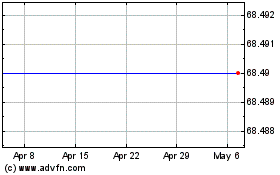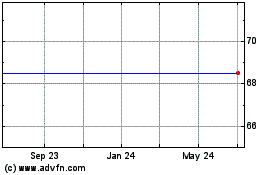Global Blood Therapeutics Announces Presentation of New Data Showing Positive Effect of GBT440 on Sickle Cell Disease Patient...
October 11 2017 - 8:00AM

First Presentation of Data Specifically Focused
on HbSC Genotype
Global Blood Therapeutics, Inc. (GBT) (NASDAQ:GBT) today announced
the presentation of a case study highlighting the effect of GBT440
on markers of anemia and hemolysis (the destruction of red blood
cells) in a patient with sickle cell disease (SCD) with the variant
HbSC genotype who participated in the Phase 1/2 GBT440-001 study.
The findings were presented for the first time at the Academy for
Sickle Cell and Thalassemia (ASCAT) 11th Annual Conference in
London. Additionally, previously announced pharmacokinetic and
safety data from the ongoing Phase 2a HOPE-KIDS 1 Study of GBT440
were presented at the conference.
“SCD patients with the HbSC genotype generally experience milder
symptoms than those with the more common HbSS genotype, however,
they still experience significant complications and morbidities,
such as painful crises, retinopathy and bone necrosis. There are no
approved therapies for patients with HbSC, who make up one third of
the SCD patient population. The findings from this case study
underscore the potential of GBT440 to be a disease-modifying
therapy across a broad population of SCD genotypes through its
ability to inhibit hemoglobin polymerization, the root cause of the
clinical manifestations of all genotypes of SCD,” said Ted W. Love,
M.D., president and chief executive officer of GBT. “As new
treatment options for people with SCD are urgently needed, we
continue to advance the clinical development of GBT440, with
clinical trials under way in pediatric, adolescent and adult
patient groups and look forward to sharing additional data from our
program at the upcoming National SCDAA Convention later this month
and at the American Society of Hematology Annual Meeting in
December.”
Efficacy of GBT440 in a Patient with HbSC
Genotype In the case study presented at ASCAT 2017, the
clinical course of a 21-year-old woman with HbSC disease and a past
medical history of vaso-occlusive crisis participated in the
GBT440-001 study and a follow-on extension study is
described. During the study, she received GBT440 orally once
daily for two months at a dose of 600 mg and subsequently for four
months at a dose of 900 mg. At six months:
- Her baseline hemoglobin increased by 2.2 g/dl, from 10.0 g/dL
to 12.2 g/dL (within the normal range).
- Her unconjugated bilirubin (a measure of red blood cell
destruction) returned to normal, decreasing by 57 percent.
- Her baseline reticulocyte count (a measure of how fast red
blood cells are made by the bone marrow and released into the blood
to compensate for hemolysis) decreased by 17 percent.
- She reported an improvement in fatigue (her primary SCD-related
symptom).
- She did not experience any sickle cell crisis events.
- She did not experience any treatment-related adverse events
with GBT440.
Encore Presentation of HOPE-KIDS 1 Study Data
The HOPE-KIDS 1 Study data presented at ASCAT 2017 were previously
presented at the 22nd Congress of the European Hematology
Association (EHA) in June. Results from the single-dose adolescent
(age 12 to 17) cohort (n=7) of this open-label, single- and
multiple-dose study, demonstrated that the pharmacokinetics and
half-life of GBT440 are similar in adolescents and adults, and that
GBT440 was well tolerated. No serious or severe adverse events
related to study drug were observed.
About Sickle Cell Disease (SCD)SCD is a
lifelong inherited blood disorder caused by a genetic mutation in
the beta-chain of hemoglobin, which leads to the formation of
abnormal hemoglobin known as sickle hemoglobin (HbS). In its
deoxygenated state, HbS has a propensity to polymerize, or bind
together, forming long, rigid rods within a red blood cell (RBC).
The polymer rods deform RBCs to assume a sickled shape and to
become inflexible, which can cause blockage in capillaries and
small blood vessels. Beginning in childhood, SCD patients suffer
unpredictable and recurrent episodes or crises of severe pain due
to blocked blood flow to organs, which often lead to psychosocial
and physical disabilities. This blocked blood flow, combined with
hemolytic anemia (the destruction of RBCs), can eventually lead to
multi-organ damage and early death.
About GBT440 in Sickle Cell DiseaseGBT440 is
being developed as an oral, once-daily therapy for patients with
SCD. GBT440 works by increasing hemoglobin's affinity for oxygen.
Since oxygenated sickle hemoglobin does not polymerize, GBT
believes GBT440 blocks polymerization and the resultant sickling of
red blood cells. With the potential to restore normal hemoglobin
function and improve oxygen delivery, GBT believes that GBT440 may
potentially modify the course of SCD. In recognition of the
critical need for new SCD treatments, the U.S. Food and Drug
Administration (FDA) has granted GBT440 Fast Track, Orphan Drug and
Rare Pediatric Disease designations for the treatment of patients
with SCD. The European Medicines Agency (EMA) has included GBT440
in its Priority Medicines (PRIME) program, and the European
Commission (EC) has designated GBT440 as an orphan medicinal
product for the treatment of patients with SCD.
GBT is currently evaluating GBT440 in the HOPE (Hemoglobin
Oxygen Affinity Modulation to Inhibit HbS PolymErization) Study, a
Phase 3 clinical trial in patients age 12 and older with SCD.
Additionally, GBT440 is being studied in the ongoing Phase 1/2
GBT440-001 trial and in the ongoing Phase 2a HOPE-KIDS 1 Study, an
open-label, single- and multiple-dose study in pediatric patients
(age 6 to 17) with SCD. HOPE-KIDS 1 is assessing the safety,
tolerability, pharmacokinetics and exploratory treatment effect of
GBT440.
About Global Blood TherapeuticsGlobal Blood
Therapeutics, Inc. is a clinical-stage biopharmaceutical company
dedicated to discovering, developing and commercializing novel
therapeutics to treat grievous blood-based disorders with
significant unmet need. GBT is developing its lead product
candidate, GBT440, as an oral, once-daily therapy for sickle cell
disease. GBT is also investigating GBT440 for the treatment of
hypoxemic pulmonary disorders in two ongoing Phase 2a studies in
patients with idiopathic pulmonary fibrosis. To learn more, please
visit: www.globalbloodtx.com and follow the company on Twitter:
@GBT_News.
Forward-Looking Statements Statements we make
in this press release may include statements that are not
historical facts and are considered forward-looking within the
meaning of Section 27A of the Securities Act of 1933, as amended
and Section 21E of the Securities Exchange Act of 1934, as amended.
We intend these forward-looking statements, including statements
regarding the therapeutic potential and safety profile of GBT440
including in particular SCD patient subpopulations such as specific
genotypes or pediatric patients, our ability to implement our
clinical development plans for GBT440 in both SCD and hypoxemic
pulmonary disorders, our ability to generate and report data from
our ongoing and potential future studies of GBT440 including in
pediatric patients, regulatory review and actions relating to
GBT440 including with respect to pediatric patients, and the timing
of these events, to be covered by the safe harbor provisions for
forward-looking statements contained in Section 27A of the
Securities Act and Section 21E of the Securities Exchange Act and
are making this statement for purposes of complying with those safe
harbor provisions. These forward-looking statements reflect our
current views about our plans, intentions, expectations, strategies
and prospects, which are based on the information currently
available to us and on assumptions we have made. We can give no
assurance that the plans, intentions, expectations or strategies
will be attained or achieved, and furthermore, actual results may
differ materially from those described in the forward-looking
statements and will be affected by a variety of risks and factors
that are beyond our control including, without limitation, the
risks that our clinical and preclinical development activities may
be delayed or terminated for a variety of reasons, that regulatory
authorities may disagree with our clinical development plans or
require additional studies or data to support further clinical
investigation of our product candidates, and that drug-related
adverse events may be observed in later stages of clinical
development, along with those risks set forth in our Annual Report
on Form 10-K for the fiscal year ended December 31, 2016 and in our
Quarterly Report on Form 10-Q for the quarter ended June 30, 2017,
as well as discussions of potential risks, uncertainties and other
important factors in our subsequent filings with the U.S.
Securities and Exchange Commission. Except as required by law, we
assume no obligation to update publicly any forward-looking
statements, whether as a result of new information, future events
or otherwise.
Contact Information:Myesha Lacy
(investors)GBT650-351-4730investor@globalbloodtx.com
Julie Normart (media)Pure
Communications415-946-1087media@globalbloodtx.com
Global Blood Therapeutics (NASDAQ:GBT)
Historical Stock Chart
From Mar 2024 to Apr 2024

Global Blood Therapeutics (NASDAQ:GBT)
Historical Stock Chart
From Apr 2023 to Apr 2024
